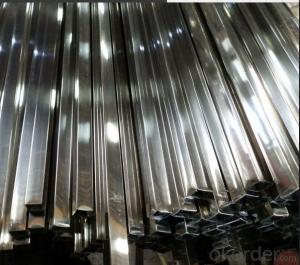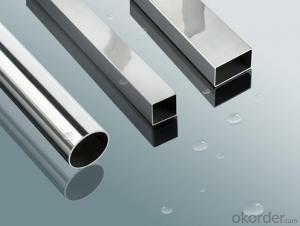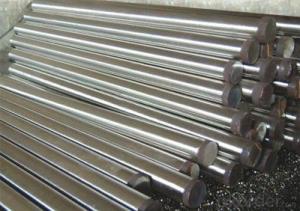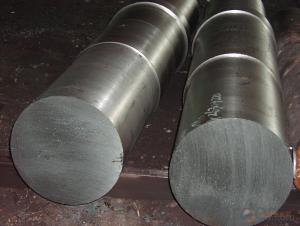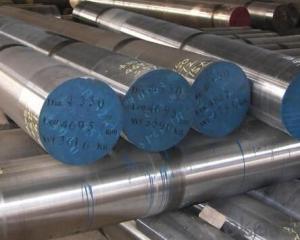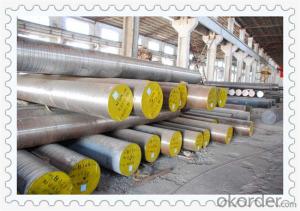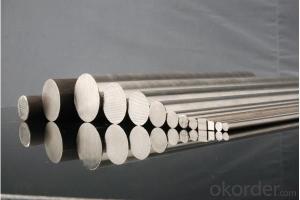High Quality Stainless Steel Round Steel bar
- Loading Port:
- Tianjin
- Payment Terms:
- TT OR LC
- Min Order Qty:
- 100 kg
- Supply Capability:
- 1000 kg/month
OKorder Service Pledge
Quality Product, Order Online Tracking, Timely Delivery
OKorder Financial Service
Credit Rating, Credit Services, Credit Purchasing
You Might Also Like

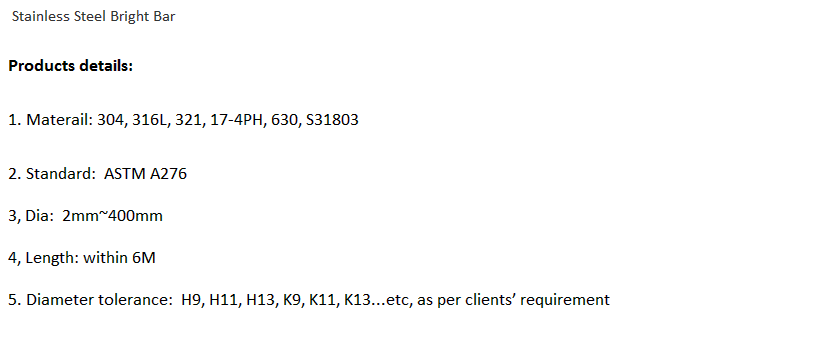



- Q: Can stainless steel pipes be used for sewage systems?
- Indeed, sewage systems can utilize stainless steel pipes. Due to its exceptional durability and resistance to corrosion, stainless steel proves itself as a fitting material for a range of uses, including sewage systems. Stainless steel pipes possess the ability to withstand the severe elements present in sewage, such as corrosive substances, elevated temperatures, and abrasive solids. Moreover, the smooth surface of stainless steel pipes reduces the likelihood of obstructions and impediments in the sewage system. As a result, stainless steel pipes offer a dependable and enduring option for sewage systems, guaranteeing an efficient and effective waste disposal process.
- Q: Is food grade stainless steel GB9684 304?
- Food grade stainless steel is in line with the GB9684 standard stainless steel.
- Q: Can stainless steel pipes be used for construction purposes?
- Indeed, construction purposes can certainly make use of stainless steel pipes. This material, known for its exceptional durability and resistance to corrosion, proves itself suitable for a wide range of construction applications. It finds common employment in structural projects, providing dependable support for building frameworks, handrails, and support structures. Moreover, stainless steel pipes serve vital roles in plumbing systems, drainage systems, and HVAC systems. Notably, they often take precedence in construction endeavors that prioritize hygiene and cleanliness, such as hospitals, food processing plants, and laboratories. In summary, stainless steel pipes deliver exceptional strength, longevity, and resistance to rust and corrosion, rendering them an unwavering choice for construction endeavors.
- Q: Can stainless steel pipes be used in the automotive industry?
- Yes, stainless steel pipes can be used in the automotive industry. Stainless steel is a highly durable and corrosion-resistant material, making it ideal for various applications in the automotive sector. Stainless steel pipes are commonly used in exhaust systems, where they can withstand high temperatures and resist the corrosive effects of gases and condensation. Additionally, stainless steel pipes are also used in fuel delivery systems, brake lines, and hydraulic systems, where their strength and resistance to corrosion are essential. Overall, stainless steel pipes offer excellent performance and longevity in the demanding conditions of the automotive industry.
- Q: How do stainless steel pipes compare to copper pipes?
- Stainless steel pipes are generally more durable, corrosion-resistant, and can withstand higher temperatures compared to copper pipes. Additionally, stainless steel pipes have a longer lifespan and require less maintenance. However, copper pipes have better heat conductivity and are easier to install. The choice between stainless steel and copper pipes depends on the specific application and requirements.
- Q: What are the different types of stainless steel pipe end connections?
- There are several different types of stainless steel pipe end connections, each designed for specific applications and requirements. Some of the most common types include: 1. Threaded connections: This type of connection features threads on the inside or outside of the pipe end, allowing it to be screwed onto another threaded fitting or pipe. Threaded connections are typically used for low-pressure applications. 2. Socket-weld connections: In this type of connection, the pipe end is inserted into a socket or recess of a socket-weld fitting and then welded around the outside of the pipe. Socket-weld connections are suitable for high-pressure applications and are known for their strength and reliability. 3. Butt-weld connections: Butt-weld connections involve welding the pipe end directly to another pipe or fitting. They are commonly used in high-pressure and high-temperature applications. 4. Flanged connections: Flanged connections feature a flange on the pipe end, which is then bolted to a mating flange on another pipe or fitting. Flanged connections are used in applications requiring easy disassembly or where there is a need for frequent maintenance. 5. Compression connections: Compression connections involve using a compression fitting to join the pipe ends. These connections are commonly used in plumbing and gas supply systems and are known for their ease of installation. 6. Grooved connections: Grooved connections involve using grooved couplings to join the pipe ends. These connections are often used in fire protection systems and are known for their quick and simple installation. Overall, the choice of stainless steel pipe end connection depends on the specific application, pressure requirements, ease of installation, and maintenance considerations. It is important to consult with a professional or refer to industry standards to determine the most suitable connection type for your particular needs.
- Q: Why does the 304 stainless steel pipe leak?
- Austenitic stainless steels are extremely sensitive to chloride ion and can occur in a very short time if the temperature and concentration are appropriate. Therefore, the relevant standards and specifications in the clear requirements for austenitic stainless steel pressure vessels for hydraulic pressure test, there are strict requirements on the chloride ion concentration of the water, and after the test to put water clean, dry. In order to avoid residual moisture in the chloride ion corrosion of stainless steel.
- Q: What's the difference between cold drawn steel tube and hot rolled steel tube?
- Cold drawn steel tubes are produced by drawing, extruding, piercing and the like. The whole steel pipe has no seams. It's a round, square, rectangular steel with a hollow cross section without any seams. It is made of steel ingot or solid pipe blank by piercing and then made by cold casting.
- Q: How do you calculate the required wall thickness of stainless steel pipes?
- In order to determine the necessary wall thickness of stainless steel pipes, it is essential to take into account several factors. The initial consideration is the internal pressure that the pipe will be subjected to. This pressure is typically expressed in pounds per square inch (psi) or bar. The formula for calculating the required wall thickness due to internal pressure is as follows: t = (P * r) / (2 * S - 1.2 * P) Here, t represents the required wall thickness, P represents the internal pressure, r represents the pipe radius, and S represents the allowable stress of the material. The second factor to consider is the external pressure that the pipe will encounter. External pressure is typically caused by elements such as soil or fluid pressure. The formula for calculating the required wall thickness due to external pressure is as follows: t = (P * r) / (2 * S + 1.2 * P) The third factor to take into account is the maximum allowable deflection of the pipe. This is crucial to ensure that the pipe does not deform or fail under specific loads. The formula for calculating the required wall thickness due to deflection is as follows: t = (0.0625 * (w * L^3)) / (E * I) In this formula, t represents the required wall thickness, w represents the uniform load on the pipe per unit length, L represents the effective length of the pipe, E represents the elastic modulus of the material, and I represents the moment of inertia of the pipe cross-section. Moreover, it is important to consider the material's yield strength when determining the required wall thickness. The yield strength indicates the maximum stress that the material can endure before experiencing permanent deformation. It is crucial to select a material and wall thickness that can withstand the anticipated loads and pressures while maintaining safety and reliability. For more accurate calculations, it is advisable to refer to relevant design codes, standards, or engineering handbooks that are specific to stainless steel pipes. It is highly recommended to seek professional advice from a qualified engineer or structural designer to ensure the accuracy and safety of the design.
- Q: What is the external insulation used for stainless steel pipes?
- Various materials like mineral wool, fiberglass, or foam are commonly utilized for the external insulation of stainless steel pipes. These insulating materials are applied to the outer surface of the pipes, serving the purpose of thermal insulation and safeguarding against heat loss or gain. By doing so, the insulation aids in sustaining the desired temperature of the fluid or substance flowing through the pipes, thereby preventing condensation and minimizing energy loss. Moreover, the external insulation acts as a barrier against corrosion and mechanical harm, guaranteeing the durability and effectiveness of the stainless steel pipes.
Send your message to us
High Quality Stainless Steel Round Steel bar
- Loading Port:
- Tianjin
- Payment Terms:
- TT OR LC
- Min Order Qty:
- 100 kg
- Supply Capability:
- 1000 kg/month
OKorder Service Pledge
Quality Product, Order Online Tracking, Timely Delivery
OKorder Financial Service
Credit Rating, Credit Services, Credit Purchasing
Similar products
Hot products
Hot Searches
Related keywords








